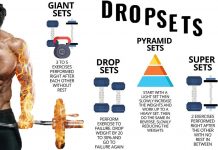🔥HOW TO BUILD UPPER & LOWER BODY WORKOUT👇
✅ Above are some exercises you would incorporate into a push/pull/legs split. The push/pull/legs split is a very simple training method in which you split your body into three parts. And each part is then trained on its own separate day

[wp_ad_camp_2]
- In the “push” workout you train all the upper body pushing muscles, i.e. the chest, shoulders and triceps.
- In the “pull” workout you train all the upper body pulling muscles, i.e. the back and biceps
- And in the “legs” workout you train the entire lower body, i.e. the quads, hamstrings, glutes & calvesThe push/pull/legs split is probably the most efficient workout split there is because all related muscle groups are trained together in the same workoutThis means that you get the maximum overlap of movements within the same workout, and the muscle groups being trained get an overall benefit from this overlap
[wp_ad_camp_1]

For example when you train chest with say bench press, you are also hitting your anterior deltoids and triceps hard. And when you train shoulders you are again involving your triceps. So it makes sense to work these all together in the same workout for maximum synergy and effectiveness
Similarly when you train your back your biceps are heavily involved, so it again makes sense to train these immediately afterwards so that they can derive the maximum benefit from the additional stimulation
It also means you will have minimum overlap of movements between workouts, and this will facilitate better recovery than most other body part splits.
🔥 Compound supersets
[wp_ad_camp_4]
A superset is what you get when you combine two exercises into one full set, with none to little rest in-between. As you can imagine, there is a ton of superset variants, but the most popular include agonist-antagonist sets (combination of two exercises that utilize different muscle groups), same/similar muscle group sets (combination of two exercises that stimulate similar muscles) and upper-lower sets (pairing an upper body exercise with a lower body movement).
Although each of them brings powerful benefits, there is one type of supersets to rule them all: the compound superset. If you want to dramatically increase the intensity of your workout and reap gains in multiple body areas, compound supersets will blow your mind. Try combining leg presses with squats, incline dumbbell presses with dips, chin-ups with lat pulldowns, or maybe overhead presses with upright rows.
🔥 Drop sets
You’ve probably done drop sets before, but perhaps you haven’t been able to squeeze the most gains out of it. If so, welcome to the 8/8/8 method. This means you’ll do a set of 8 reps to failure, then decrease the weight (so that it’s still heavy yet allows for another 8) and do another set of 8 reps.
Drop the weight again and end with a final set of 8. Since they increase the intensity of the training in such a unique way, drop sets are superb for gaining overall mass – they help you recruit different muscle fibers and grow like a beast. In addition, they allow you to get more good-quality work done in less time!
[wp_ad_camp_3]

🔥 Rest/pause
This gem of a technique will help you to thoroughly fatigue your muscle fibers and break through seemingly invincible training plateaus. It basically breaks down one set into more mini-sets, which are separated by a short rest. To do it properly, set a weight that’s 80-85% of your 1RM and perform as many reps as you possible can until you reach failure.
Then rest for 20 seconds and continue. Once you hit failure again, stop and rest for 20 seconds. And go back for one final round. Even though rest/pause training has obvious benefits, it doesn’t mix well with squats and deadlifts, so you’d be better off sticking to straight sets for them.
You might also like : The DoggCrapp Training Method
[wp_ad_camp_5]

🔥 Pre-exhaustion
Now here’s a very simple but brilliant idea: using a single-joint exercise for a certain muscle group before moving on to a compound exercise for that same muscle group in order to maximize muscle damage and spur massive growth. For example, you can do flyes before your bench presses, lateral raises before overhead presses or pullovers before chin-ups or rows.
[wp_ad_camp_2]
This way you force your muscles to work twice as hard and activate as many muscle fibers of the targeted muscle group as possible. Also, pre-exhaust training works wonders for those struggling with size and strength plateaus. That being said, beginners are not advised to attempt this type of training because it can quickly lead to overtraining.
These four methods have countless variants and we encourage you to create your own combinations of exercises based on what kind of results you want to see. Now that we’ve got the basics covered, it’s time to pump some iron! Good luck!

















































